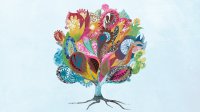4 Ways to Celebrate Cultural Identities All Year
Highlighting the accomplishments of diverse Americans can be part of daily classroom lessons—in any content area.
Your content has been saved!
Go to My Saved Content.Every year after December break, Martin Luther King Jr. Day kicks off the heritage celebrations that pepper our school and personal calendars. By the time testing season rolls around, schools have celebrated Black history, women’s history, Arab American heritage, Jewish American heritage, Asian American and Pacific Islander Month, and Autism Acceptance Month, and, if they are older, they have possibly taken part in an assembly aimed at preventing sexual harassment and violence.
Celebrating the accomplishments of diverse Americans is a wonderful way to help our students gain cultural competency through the stories of people and communities not often featured in our textbooks. More important, these annual traditions also give us an opportunity to talk about why so many stories, heroes, and contributors are missing.
Just why do we highlight Black narratives mostly in February and Indigenous voices mostly in November? Why have the contributions of Asian Americans, Arab Americans, and women been centered only during their months and not interwoven into daily lesson plans? Why did we never learn that Thomas Edison was severely hearing impaired or know that Helen Keller was only one of many prominent writers with disabilities?
Understanding the Rules vs. Exceptions
The people who write and sell books, encyclopedias, and historical tomes are, and have been, mostly White, cisgender, and nondisabled. That means that it’s more likely that the stories and heroes they know and discuss in their work are often also White, cisgender, and nondisabled. That’s not an indictment; a child raised near the beach draws the ocean, a child raised in Switzerland draws the Alps.
There is an African proverb that says, “Until the lions have their historians, tales of the hunt shall always glorify the hunter.” In other words, there is a rule of thumb in our country that influences who tells stories and the perspectives from which stories are told. When we realize that some narratives are traditionally centered and others aren’t, designated months of recognition and celebration put a spotlight on untold stories.
However, it’s possible to value diverse narratives without confining them to certain months. Below are four areas where we can make changes in order to ensure that the stories of all Americans are highlighted throughout the year.
1. Assess the Curriculum
American history is often told from the colonial perspective, but Indigenous American history spans thousands of years on North American soil, just as African American history predates the founding of the United States of America by at least 150 years. Those are stories we rarely hear about. To explore history with as many diverse stories and perspectives as possible, historian and professor Leslie Madsen-Brooks offers a wealth of information. If you are an AP teacher, be sure to connect with higher-ed liaisons and your administrators to ensure that you can follow local laws while still preparing your students for AP exams.
Women and people of non-European descent are often underrepresented in STEM, largely because of the talent pipeline. Educators can change that. According to an article in the International Journal of STEM Education, “Students who express interest in STEM in eighth grade are up to three times more likely to ultimately pursue STEM degrees later in life.”
Encourage diversity by exposing students to mathematicians and scientists with diverse cultural backgrounds. If the Pew statistic says 1 in 20 people identifies as LGBTQ, then in a class of 20+ you most likely have students from the community to welcome and support. Learning for Justice has lesson plans on a variety of themes for all grade levels. As educators, we sometimes lose sight of our sole purpose, to educate students, not judge them according to our personal preferences. If you are a conservative public school educator wrestling with this content, seek helpful steps toward understanding and acceptance.
2. Explore Your Classroom
Completing a diversity audit is a good way to ensure that all kinds of people and stories are represented. Diversity audit is fancy terminology for looking at a learning environment to see if all of the materials look like you or if diverse identities and narratives are represented. Have diverse dolls, books, and even “colors of the world.” Crayons go a long way toward adding diversity to your classroom. Playing diverse styles of music is also a good way to broaden cultural horizons for all your students.
Finally, sometimes our most well-intentioned belonging and inclusion strategies don’t have the intended outcomes. My article at Cult of Pedagogy, “Are Your Diversity Strategies Missing the Mark?,” will give you some food for thought as well as strategies for teaching in diverse classrooms.
3. Consider Your Campus
Beverly Daniel Tatum’s conference talk based on her book Why Are All the Black Kids Sitting Together in the Cafeteria? is a powerful, nuanced, and authentic discussion on the complexities of race. Consider using the book for a staff book study.
If you are a primary educator in a low-diversity school, consider joining a program like Empatico to make connections and increase cultural literacy in your school.
4. Reach Out to the Community
Getting parents on board is helpful for building a trusting learning community. Use this community collaboration tool kit from the Learning Accelerator to implement ideas from the community, rather than interacting largely through emails and newsletters.
Finally, take a look around your school. Would people of every hue, culture, and identity see themselves reflected on your walls, in your books, and through your daily conversations? If not, use the above resources to evaluate, reflect, and make the changes necessary so that months simply highlight what we do in our classrooms every day.
